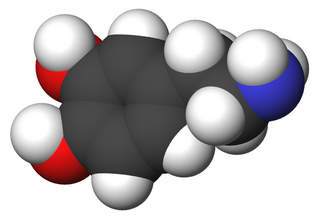A mental disorder, also referred to as a mental illness, a mental health condition, or a psychiatric disability, is a behavioral or mental pattern that causes significant distress or impairment of personal functioning. A mental disorder is also characterized by a clinically significant disturbance in an individual's cognition, emotional regulation, or behavior, often in a social context. Such disturbances may occur as single episodes, may be persistent, or may be relapsing–remitting. There are many different types of mental disorders, with signs and symptoms that vary widely between specific disorders. A mental disorder is one aspect of mental health.
Psychosis is a condition of the mind or psyche that results in difficulties determining what is real and what is not real. Symptoms may include delusions and hallucinations, among other features. Additional symptoms are disorganized thinking and incoherent speech and behavior that is inappropriate for a given situation. There may also be sleep problems, social withdrawal, lack of motivation, and difficulties carrying out daily activities. Psychosis can have serious adverse outcomes.

Schizophrenia is a mental disorder characterized by hallucinations, delusions, disorganized thinking and behavior, and flat or inappropriate affect. Symptoms develop gradually and typically begin during young adulthood and are never resolved. There is no objective diagnostic test; diagnosis is based on observed behavior, a psychiatric history that includes the person's reported experiences, and reports of others familiar with the person. For a diagnosis of schizophrenia, the described symptoms need to have been present for at least six months or one month. Many people with schizophrenia have other mental disorders, especially mood disorders, anxiety disorders, and obsessive–compulsive disorder.
Sex differences in medicine include sex-specific diseases or conditions which occur only in people of one sex due to underlying biological factors ; sex-related diseases, which are diseases that are more common to one sex ; and diseases which occur at similar rates in males and females but manifest differently according to sex.
Schizoaffective disorder is a mental disorder characterized by symptoms of both schizophrenia (psychosis) and a mood disorder - either bipolar disorder or depression. The main diagnostic criterion is the presence of psychotic symptoms for at least two weeks without prominent mood symptoms. Common symptoms include hallucinations, delusions, disorganized speech and thinking, as well as mood episodes. Schizoaffective disorder can often be misdiagnosed when the correct diagnosis may be psychotic depression, bipolar I disorder, schizophreniform disorder, or schizophrenia. This is a problem as treatment and prognosis differ greatly for most of these diagnoses. Many people with schizoaffective disorder have other mental disorders including anxiety disorders.

Tardive dyskinesia (TD) is an iatrogenic disorder that results in involuntary repetitive body movements, which may include grimacing, sticking out the tongue or smacking the lips, which occurs following treatment with medication. Additional motor symptoms include chorea or athetosis. In about 20% of people with TD, the disorder interferes with daily functioning. If TD is present in the setting of a long-term drug therapy, reversibility can be determined primarily by severity of symptoms and how long symptoms have been present before the long-term drug has been stopped.
Schizotypal personality disorder, also known as schizotypal disorder, is a cluster A personality disorder. The Diagnostic and Statistical Manual of Mental Disorders (DSM) classification describes the disorder specifically as a personality disorder characterized by thought disorder, paranoia, a characteristic form of social anxiety, derealization, transient psychosis, and unconventional beliefs. People with this disorder feel pronounced discomfort in forming and maintaining social connections with other people, primarily due to the belief that other people harbor negative thoughts and views about them. Peculiar speech mannerisms and socially unexpected modes of dress are also characteristic. Schizotypal people may react oddly in conversations, not respond, or talk to themselves. They frequently interpret situations as being strange or having unusual meanings for them; paranormal and superstitious beliefs are common. Schizotypal people usually disagree with the suggestion that their thoughts and behaviors are a 'disorder' and seek medical attention for depression or anxiety instead. Schizotypal personality disorder occurs in approximately 3% of the general population and is more commonly diagnosed in males.
Premenstrual dysphoric disorder (PMDD) is a mood disorder characterized by emotional, cognitive, and physical symptoms. PMDD causes significant distress or impairment in menstruating women during the luteal phase of the menstrual cycle. The symptoms occur in the luteal phase, improve within a few days after the onset of menses, and are minimal or absent in the week after menses. PMDD has a profound impact on a woman’s quality of life and dramatically increases the risk of suicidal ideation and even suicide attempts. Many women of reproductive age experience discomfort or mild mood changes prior to menstruation. However, 5–8% experience severe premenstrual syndrome causing significant distress or functional impairment. Within this population of reproductive age, some will meet the criteria for PMDD.
Sex differences in psychology are differences in the mental functions and behaviors of the sexes and are due to a complex interplay of biological, developmental, and cultural factors. Differences have been found in a variety of fields such as mental health, cognitive abilities, personality, emotion, sexuality, friendship, and tendency towards aggression. Such variation may be innate, learned, or both. Modern research attempts to distinguish between these causes and to analyze any ethical concerns raised. Since behavior is a result of interactions between nature and nurture, researchers are interested in investigating how biology and environment interact to produce such differences, although this is often not possible.
Thought broadcasting is a type of delusional condition in which the affected person believes that others can hear their inner thoughts, despite a clear lack of evidence. The person may believe that either those nearby can perceive their thoughts or that they are being transmitted via mediums such as television, radio or the internet. Different people can experience thought broadcasting in different ways. Thought broadcasting is most commonly found among people who have a psychotic disorder, specifically schizophrenia.
Sex is correlated with the prevalence of certain mental disorders, including depression, anxiety and somatic complaints. For example, women are more likely to be diagnosed with major depression, while men are more likely to be diagnosed with substance abuse and antisocial personality disorder. There are no marked gender differences in the diagnosis rates of disorders like schizophrenia and bipolar disorder. Men are at risk to suffer from post-traumatic stress disorder (PTSD) due to past violent experiences such as accidents, wars and witnessing death, and women are diagnosed with PTSD at higher rates due to experiences with sexual assault, rape and child sexual abuse. Nonbinary or genderqueer identification describes people who do not identify as either male or female. People who identify as nonbinary or gender queer show increased risk for depression, anxiety and post-traumatic stress disorder. People who identify as transgender demonstrate increased risk for depression, anxiety, and post-traumatic stress disorder.
Schizophrenia is a neurodevelopmental disorder with no precise or single cause. Schizophrenia is thought to arise from multiple mechanisms and complex gene–environment interactions with vulnerability factors. Risk factors of schizophrenia have been identified and include genetic factors, environmental factors such as experiences in life and exposures in a person's environment, and also the function of a person's brain as it develops. The interactions of these risk factors are intricate, as numerous and diverse medical insults from conception to adulthood can be involved. Many theories have been proposed including the combination of genetic and environmental factors may lead to deficits in the neural circuits that affect sensory input and cognitive functions.
Paradoxical laughter is an exaggerated expression of humour which is unwarranted by external events. It may be uncontrollable laughter which may be recognised as inappropriate by the person involved. It is associated with mental illness, such as mania, hypomania or schizophrenia, schizotypal personality disorder and can have other causes. Paradoxical laughter is indicative of an unstable mood, often caused by the pseudobulbar affect, which can quickly change to anger and back again, on minor external cues.

The prevalence of mental disorders has been studied around the world, providing estimates on how common mental disorders are. Different criteria or thresholds of severity have sometimes been used.
Childhood schizophrenia is similar in characteristics of schizophrenia that develops at a later age, but has an onset before the age of 13 years, and is more difficult to diagnose. Schizophrenia is characterized by positive symptoms that can include hallucinations, delusions, and disorganized speech; negative symptoms, such as blunted affect and avolition and apathy, and a number of cognitive impairments. Differential diagnosis is problematic since several other neurodevelopmental disorders, including autism spectrum disorder, language disorder, and attention deficit hyperactivity disorder, also have signs and symptoms similar to childhood-onset schizophrenia.

The prognosis of schizophrenia is varied at the individual level. In general it has great human and economics costs. It results in a decreased life expectancy of 12–15 years primarily due to its association with obesity, little exercise, and smoking, while an increased rate of suicide plays a lesser role. These differences in life expectancy increased between the 1970s and 1990s, and between the 1990s and 2000s. This difference has not substantially changed in Finland for example – where there is a health system with open access to care.
The diagnosis of schizophrenia, a psychotic disorder, is based on criteria in either the American Psychiatric Association's Diagnostic and Statistical Manual of Mental Disorders, or the World Health Organization's International Classification of Diseases (ICD). Clinical assessment of schizophrenia is carried out by a mental health professional based on observed behavior, reported experiences, and reports of others familiar with the person. Diagnosis is usually made by a psychiatrist. Associated symptoms occur along a continuum in the population and must reach a certain severity and level of impairment before a diagnosis is made. Schizophrenia has a prevalence rate of 0.3-0.7% in the United States.

Schizophrenia affects around 0.3–0.7% of the general population at some point in life, or 21 million people worldwide as of 2020. By using precise methods in its diagnosis and a large, representative population, schizophrenia seems to occur with relative consistency over time during the last half-century.
Schizophrenia is a mental disorder characterized by persistent hallucinations, delusions, paranoia, and thought disorder. These experiences are evident in multiple sensory modalities and include deviation in all facets of thought, cognition, and emotion. Compared to other psychological disorders like major depressive disorder (MDD) and generalized anxiety disorder (GAD), schizophrenia has significantly higher heritability. Schizophrenia has been found to present cross-culturally, and it almost always has 0.1% prevalence in a given population, although some studies have cast doubts on this. It has been hypothesized that schizophrenia is unique to human beings and has existed for a long time.
The male-female health survival paradox, also known as the morbidity-mortality paradox or gender paradox, is the phenomenon in which female humans experience more medical conditions and disability during their lives, but they unexpectedly live longer than males. This paradox, where females experience greater morbidity (diseases) but lower mortality (death) in comparison to males, is unusual since it is expected that experiencing disease increases the likelihood of death. However, in this case, the part of the population that experiences more disease and disability is the one that lives longer.





